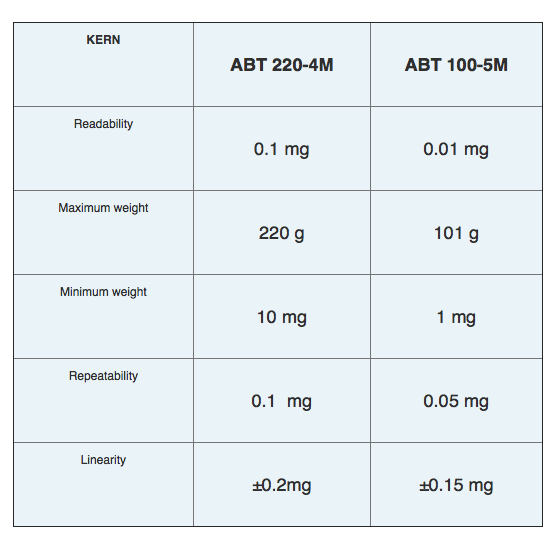Members Login

Channels
Special Offers & Promotions
Tips on Selecting a Laboratory Balance
A lot goes into selecting a laboratory balance. Let’s start with weight.
 You’ll need to select a balance that displays sample weight to the resolution desired. This is described as readout. Readout can be to several decimal places presented in grams or milligrams.
You’ll need to select a balance that displays sample weight to the resolution desired. This is described as readout. Readout can be to several decimal places presented in grams or milligrams.
Select a balance with a weighing capacity in excess of the samples you plan to weigh. Some balances also specify the minimum load that can be placed on the weighing plate.
Why is this you ask? If the sample weight is not much larger than the expected weighing error, the measured value will be neither accurate nor repeatable. For this reason the spec sheet for laboratory balances may specify a minimum load. For the Kern ABT 0.1 mg readout balances available with maximum loads of 120, 220 and 320 grams the minimum load is 10 mg. But if you want to weigh samples less than 10 mg the Kern ABT 100-5M balance has readout of 0.01 mg and a minimum 1 mg load. As weight capacity increases it can start to impact scale performance linearity described below. That’s why it is important to take into account all performance specs when selecting your laboratory balance.
Sources of Balance Weighing Errors
Balance errors are expressed several ways including: linearity and repeatability. Linearity describes the maximum difference between the true weight of the sample over its weighing range and the deviation of readout from that weight. If you draw a plot of the real sample weight vs. the weight displayed, for a perfect balance this plot would be a straight line. But nothing is perfect. Laboratory balance specification tables present linearity as a plus/minus (±) figure which represents the maximum ± deviation of the curve from the straight line. For ABT balances with a 10 mg minimum sample size linearity is ±0.2 mg or ±0.3 mg depending on balance capacity; for the ABT balance with a 1 mg minimum load and 101 g capacity linearity is ±0.15 mg.
Note well that when weighing to FDA and USP standards (see below) you will not depend on the balance manufacturer’s spec sheet to determine linearity. You must take several readings using calibrated test weights and record the difference, if any, between the test weight and the displayed weight. If the ± variation falls outside FDA and USP guidelines you should purchase a balance with tighter linearity specifications.
Repeatability (designated by some manufacturers as reproducibility) is the ability of a balance to display the same result when an object is repeatedly weighed under the same conditions. Repeatability is usually the standard deviation of 10 consecutive measurements of a calibrated test weight. In the 10 mg minimum load balances discussed here repeatability is 0.1 mg, and for the 1 mg minimum load balance it is 0.05 mg.
Regulatory agencies define reproducibility in a different way, that is a balance’s ability to deliver the same results under varied conditions, such as different locations or when operated by different technicians. Day to day variation in a balance’s repeatability measurements is typically larger than the manufacturer’s repeatability specification for the balance.
What does all this mean? It can mean a lot if weighing operations are subject to monitoring by the FDA. USP 41 defines minimum quality standards for laboratory balances; USP 1251 provides guidelines specifically for analytical balances including determination of a minimum sample weight. They are rigidly defined and should govern your balance selection because as noted above you are responsible for testing the balance you select.
Our advice is selecting lab balances with capabilities that meet your particular requirements – including those established by organizations such as USP and the FDA. The scientists at Tovatech are ready to help.
But That’s Not All
Analytical balance accuracy is highly dependent on where the instrument is placed and how it is maintained. We direct your attention to our post on setting up and maintaining your balance to avoid weighing errors and to insure long term reliable performance. Again we invite you to contact our experts for advice and suggestions on choosing the correct balance for your weighing requirements.
Media Partners


